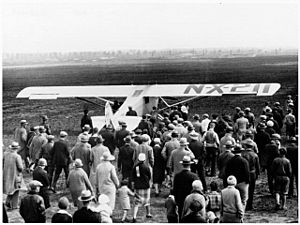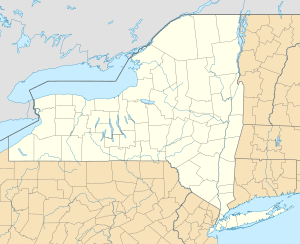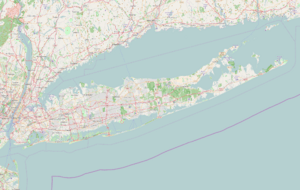Roosevelt Field (airport) facts for kids
Quick facts for kids
Roosevelt Field
Hazelhurst Field
Hempstead Plains Aerodrome
|
|
|---|---|

Nearly a thousand people assembled at Roosevelt Field to see Charles Lindbergh take off in the Spirit of St. Louis, May 20, 1927
|
|
| Summary | |
| Serves | Westbury, New York |
| Built | 1916 |
| In use | 1916–1951 |
| Commander | Training Section, Air Service (1916–1920) |
| Occupants | World War I (1916–1920) |
| Coordinates | 40°44′17″N 73°36′46″W / 40.737983°N 73.612892°W |
| Map | |
Roosevelt Field was a famous airport in Westbury, Long Island, New York. It was first known as the Hempstead Plains Aerodrome. During World War I, it served as a training field for the Air Service, United States Army.
In 1919, the airport was renamed to honor Quentin Roosevelt, the son of President Theodore Roosevelt. Quentin was a pilot who died in air combat during World War I.
Roosevelt Field became famous as the starting point for many important flights. These included Charles Lindbergh's solo transatlantic flight in 1927. Other brave pilots like Amelia Earhart and Wiley Post also used this historic airfield.
Contents
History of Roosevelt Field
The Hempstead Plains Aerodrome was a large area of land. It covered about 900 to 1000 acres. In July 1916, the U.S. Army Signal Corps set up a pilot training school there. This school was for members of the National Guard.
Roosevelt Field During World War I
When the U.S. joined World War I in April 1917, the Army took over the entire field. They renamed it Hazelhurst Field. This name honored Leighton Wilson Hazelhurst Jr., an early military pilot. He was a graduate of the United States Military Academy. Hazelhurst died in an airplane accident in 1912.
More land was added nearby for expansion. This new area became Camp Mills and Hazelhurst Aviation Field No. 2. Hazelhurst Field No. 2 was later renamed Mitchel Field in July 1918. This was to remember John Purroy Mitchel, a former New York mayor. He died in a flying accident while training with the U.S. Air Service.
On September 24, 1918, the eastern part of Hazelhurst Field No. 1 became Roosevelt Field.
First Atlantic Crossing by Airship
On July 5, 1919, a British airship called the R34 (airship) landed at Roosevelt Field. It had just completed the first flight across the Atlantic Ocean from east to west. Later, it flew back to Britain, becoming the first aircraft to cross the Atlantic in both directions.
After the war ended, the Army allowed companies to use the fields. However, the government kept control until July 1, 1920. Then, they sold their buildings and gave up control of the property.
Roosevelt Field's Civilian Use
Once the land was owned by civilians, parts of it were sold. The remaining land was split into two areas. Curtiss Field was a 300-acre airport on the original Hazelhurst Field site. Roosevelt Field took up the rest of the land. It had seven hangars and a large parking area. It also had a long, packed clay runway, about 5000 feet long.
In 1926, pilot René Fonck tried to take off from Roosevelt Field. He was attempting to win the Orteig Prize. His plane, the Sikorsky S-35, was too heavy. It crashed and caught fire, and two crew members died.
The next May, Charles Lindbergh used the Roosevelt Field runway. He took off in his plane, the Spirit of St. Louis, for his famous flight to Paris. He flew from a hangar at Curtiss Field.
In 1929, Roosevelt Field, Inc. bought both fields. The western field was called "Unit 2," and the runway was "Unit 1." They were connected, and the whole property was named Roosevelt Field. In 1936, Unit 1 was sold and became the Roosevelt Raceway. Unit 2 continued to operate as Roosevelt Field. In the 1930s, it was the busiest civilian airport in America.
Roosevelt Field Closes Its Doors
Roosevelt Field was used by the Navy and Army during World War II. After the war, it went back to being a commercial airport. However, real estate developers bought it in 1950. The airport officially closed on May 31, 1951.
The eastern part of the field first became an industrial park. Now, it is mostly retail stores and townhouses. This includes the Mall at The Source, which is on the site of the old runway. The original flying field from 1911–1916 is now a large shopping mall.
Aviation History Fresco
Aline Rhonie Hofheimer (1909–1963) was an artist. She painted a very long fresco, 126 feet long, about aviation history. It was originally at Roosevelt Field. This amazing artwork has since been moved. You can now see it at the Vaughn College of Aeronautics and Technology in Queens, New York.
Roosevelt Field Shopping Mall
In 1950, a real estate company called Webb and Knapp took control of the airfield. They later built light factories on the land that was once Unit 2. Today, this area is home to the Roosevelt Field Mall and Garden City Plaza.
Roosevelt Field in Popular Culture
- In Arthur J. Burks' story "Haunted Hangars" (1930), the airport is called "Mineola field."
- In James Thurber’s short story “The Greatest Man in the World,” the character Jack ‘Pal’ Smurch starts and finishes his round-the-world flight at Roosevelt Field.




